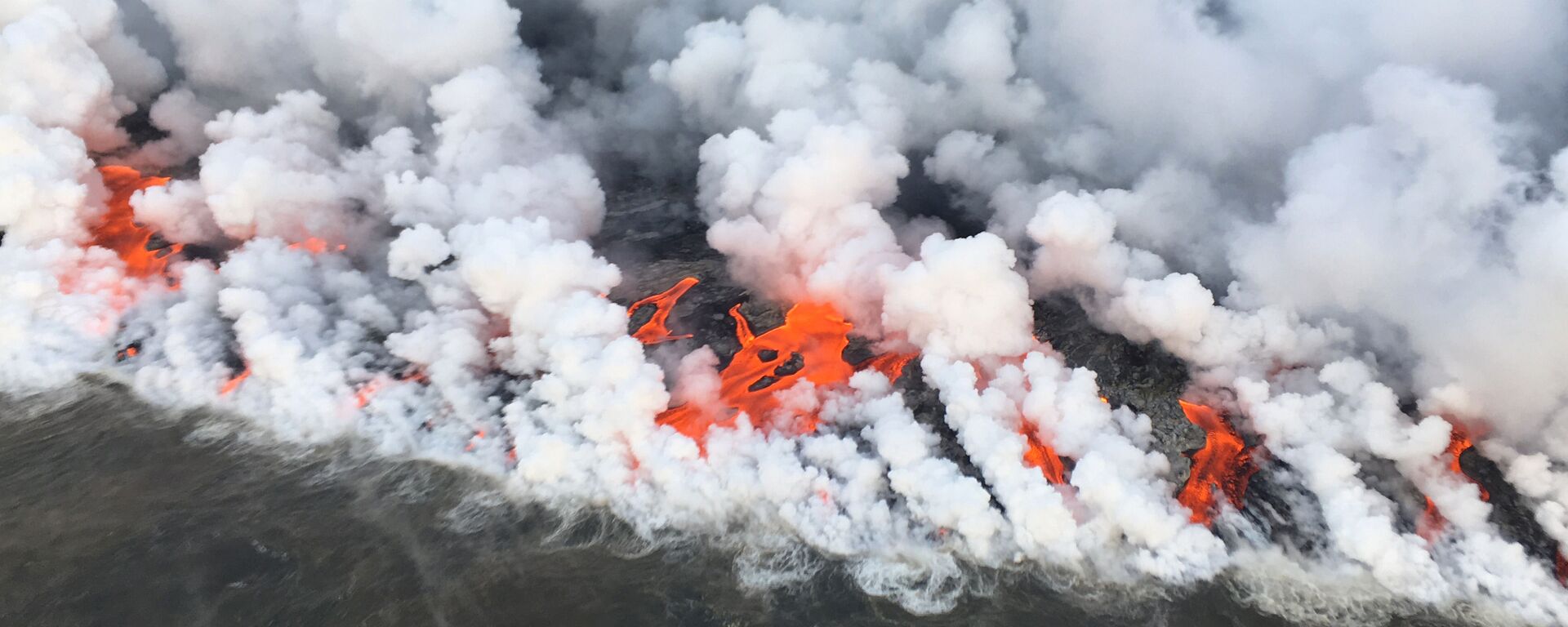https://sputnikglobe.com/20220530/scientists-discover-birthplace-of-worlds-most-active-volcano--1095884278.html
Scientists Discover 'Birthplace' of World's Most Active Volcano
Scientists Discover 'Birthplace' of World's Most Active Volcano
Sputnik International
Despite frequent eruptions, volcanologists misinterpreted the seismic data several times, erroneously thinking that the source of the volcano's magma lay close... 30.05.2022, Sputnik International
2022-05-30T18:58+0000
2022-05-30T18:58+0000
2022-05-30T18:58+0000
world
science & tech
volcano
https://cdn1.img.sputnikglobe.com/img/106542/89/1065428942_0:0:3001:1688_1920x0_80_0_0_7eca12f17e487340d05a84424c1478ca.jpg
Scientists from Monash University in Australia believe they have finally discovered the true source of the magma that Kilauea, Earth's most active volcano located in Hawaii, has been spewing.Previously, they considered a shallow chamber located 11 kilometres under the surface to be the source for the frequent eruptions. However, recent studies showed that the magma came from a chamber located as deep as 100 kilometres underground.The previous evaluation was based on the seismic waves registered back in 2014, but upon studying the composition of the magma, the scientists realised that the volcano's "heart" must lie much deeper. A closer look revealed that it contained fragments of rock and materials that can only be found in layers some 90 kilometres below or lower.To prove their results, researchers recreated the conditions that magma experiences at such levels: temperatures above 1,100C and pressure around 3 GPa, placing synthetic rocks into the conditions to melt, according to the lead geologist Laura Miller.In addition to the discovery, scientists detected garnet, a crystal that forms in layers between 100 and 150 kilometres down, in Kilauea’s magma, meaning that its source had to lie very deep underground.The researchers' discovery also shed light on how the Kilauea volcano came to be. While originally it was believed to have been formed out of a solid rock melted by the emerging lava, now scientists believe it was created following a shift of the Pacific tectonic plate almost 300,000 years ago which led to magma being cast out into the sea and eventually solidifying and creating the volcano on the surface.Let's stay in touch no matter what! Follow our Telegram channel to get all the latest news: https://t.me/sputniknewsus
https://sputnikglobe.com/20201221/kilauea-volcano-erupts-in-hawaii---photos-1081524252.html
Sputnik International
feedback@sputniknews.com
+74956456601
MIA „Rossiya Segodnya“
2022
Tim Korso
https://cdn1.img.sputnikglobe.com/img/07e6/03/0d/1093831826_0:0:216:216_100x100_80_0_0_e3f43a960af0c6c99f7eb8ccbf5f812c.jpg
Tim Korso
https://cdn1.img.sputnikglobe.com/img/07e6/03/0d/1093831826_0:0:216:216_100x100_80_0_0_e3f43a960af0c6c99f7eb8ccbf5f812c.jpg
News
en_EN
Sputnik International
feedback@sputniknews.com
+74956456601
MIA „Rossiya Segodnya“
Sputnik International
feedback@sputniknews.com
+74956456601
MIA „Rossiya Segodnya“
Tim Korso
https://cdn1.img.sputnikglobe.com/img/07e6/03/0d/1093831826_0:0:216:216_100x100_80_0_0_e3f43a960af0c6c99f7eb8ccbf5f812c.jpg
science & tech, volcano
Scientists Discover 'Birthplace' of World's Most Active Volcano
Despite frequent eruptions, volcanologists misinterpreted the seismic data several times, erroneously thinking that the source of the volcano's magma lay close to the surface.
Scientists from Monash University in Australia believe they have finally discovered the true source of the magma that Kilauea, Earth's
most active volcano located in Hawaii, has been spewing.
Previously, they considered a shallow chamber located 11 kilometres under the surface to be the source for the frequent eruptions. However, recent studies showed that the magma came from a chamber located as deep as 100 kilometres
underground.

21 December 2020, 09:04 GMT
The previous evaluation was based on the seismic waves registered back in 2014, but upon studying the composition of the magma, the scientists realised that the volcano's "heart" must lie much deeper. A closer look revealed that it contained fragments of rock and materials that can only be found in layers some 90 kilometres below or lower.
To prove their results, researchers recreated the conditions that magma experiences at such levels: temperatures above 1,100C and pressure around 3 GPa, placing synthetic rocks into the conditions to melt, according to the lead geologist Laura Miller.
In addition to the discovery, scientists detected garnet, a crystal that forms in layers between 100 and 150 kilometres down, in Kilauea’s magma, meaning that its source had to lie very deep underground.
The researchers' discovery also shed light on how the Kilauea volcano came to be. While originally it was believed to have been formed out of a solid rock melted by the
emerging lava, now scientists believe it was created following a shift of the Pacific tectonic plate almost 300,000 years ago which led to magma being cast out into the sea and eventually solidifying and creating the volcano on the surface.
Let's stay in touch no matter what! Follow our Telegram channel to get all the latest news: https://t.me/sputniknewsus 



